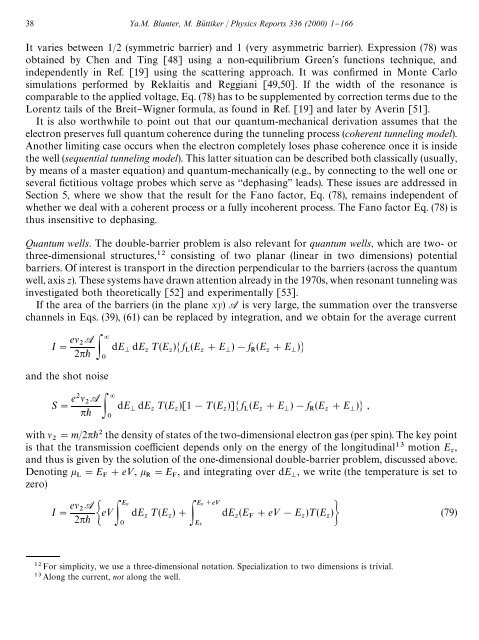shot noise in mesoscopic conductors - Low Temperature Laboratory
shot noise in mesoscopic conductors - Low Temperature Laboratory
shot noise in mesoscopic conductors - Low Temperature Laboratory
You also want an ePaper? Increase the reach of your titles
YUMPU automatically turns print PDFs into web optimized ePapers that Google loves.
38 Ya.M. Blanter, M. Bu( ttiker / Physics Reports 336 (2000) 1}166<br />
It varies between 1/2 (symmetric barrier) and 1 (very asymmetric barrier). Expression (78) was<br />
obta<strong>in</strong>ed by Chen and T<strong>in</strong>g [48] us<strong>in</strong>g a non-equilibrium Green's functions technique, and<br />
<strong>in</strong>dependently <strong>in</strong> Ref. [19] us<strong>in</strong>g the scatter<strong>in</strong>g approach. It was con"rmed <strong>in</strong> Monte Carlo<br />
simulations performed by Reklaitis and Reggiani [49,50]. If the width of the resonance is<br />
comparable to the applied voltage, Eq. (78) has to be supplemented by correction terms due to the<br />
Lorentz tails of the Breit}Wigner formula, as found <strong>in</strong> Ref. [19] and later by Aver<strong>in</strong> [51].<br />
It is also worthwhile to po<strong>in</strong>t out that our quantum-mechanical derivation assumes that the<br />
electron preserves full quantum coherence dur<strong>in</strong>g the tunnel<strong>in</strong>g process (coherent tunnel<strong>in</strong>g model).<br />
Another limit<strong>in</strong>g case occurs when the electron completely loses phase coherence once it is <strong>in</strong>side<br />
the well (sequential tunnel<strong>in</strong>g model). This latter situation can be described both classically (usually,<br />
by means of a master equation) and quantum-mechanically (e.g., by connect<strong>in</strong>g to the well one or<br />
several "ctitious voltage probes which serve as `dephas<strong>in</strong>ga leads). These issues are addressed <strong>in</strong><br />
Section 5, where we show that the result for the Fano factor, Eq. (78), rema<strong>in</strong>s <strong>in</strong>dependent of<br />
whether we deal with a coherent process or a fully <strong>in</strong>coherent process. The Fano factor Eq. (78) is<br />
thus <strong>in</strong>sensitive to dephas<strong>in</strong>g.<br />
Quantum wells. The double-barrier problem is also relevant for quantum wells, which are two- or<br />
three-dimensional structures, consist<strong>in</strong>g of two planar (l<strong>in</strong>ear <strong>in</strong> two dimensions) potential<br />
barriers. Of <strong>in</strong>terest is transport <strong>in</strong> the direction perpendicular to the barriers (across the quantum<br />
well, axis z). These systems have drawn attention already <strong>in</strong> the 1970s, when resonant tunnel<strong>in</strong>g was<br />
<strong>in</strong>vestigated both theoretically [52] and experimentally [53].<br />
If the area of the barriers (<strong>in</strong> the plane xy) A is very large, the summation over the transverse<br />
channels <strong>in</strong> Eqs. (39), (61) can be replaced by <strong>in</strong>tegration, and we obta<strong>in</strong> for the average current<br />
I" e A<br />
2 <br />
dE dE ¹(E ) f (E #E )!f (E #E )<br />
<br />
<br />
and the <strong>shot</strong> <strong>noise</strong><br />
S" e A<br />
<br />
dE dE ¹(E )[1!¹(E )] f (E #E )!f (E #E ) ,<br />
<br />
<br />
with "m/2 the density of states of the two-dimensional electron gas (per sp<strong>in</strong>). The key po<strong>in</strong>t<br />
<br />
is that the transmission coe$cient depends only on the energy of the longitud<strong>in</strong>al motion E ,<br />
<br />
and thus is given by the solution of the one-dimensional double-barrier problem, discussed above.<br />
Denot<strong>in</strong>g "E #e
















